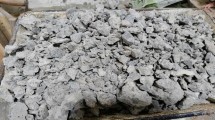Abstract
The purpose of the present research is to investigate the sustainable performance of fly ash concrete at elevated temperature. Initially, the optimum level of cement replacement with class F fly ash was determined. The concrete mixes, i.e., plain concrete (0% fly ash), 25% fly ash, and optimum level of cement replacement with fly ash (i.e., 40%), were chosen to determine the residual compressive strength of concrete after a single heating-cooling cycle of elevated temperature ranging from ambient to 400 °Cat an interval of 200 °C under unstressed and stressed conditions. The microstructure by scanning electron microscopy (SEM) was also examined for all the concrete mixes. During the heating-cooling process, the hysteresis loop at 400 °C is found larger than the hysteresis loop at 200 °C and ambient temperature. The 40% fly ash concrete showed a lower reduction in the residual compressive strength after heating at 400 °C under the unstressed condition. The 40% fly ash concrete has shown maximum residual compressive strength than 25% fly ash and plain concrete after heating at 200 °C and 400 °C under the unstressed and stressed conditions. The SEM analysis indicates a massive change in the morphology at 400 °C for plain and fly ash concrete mixes.











Similar content being viewed by others
References
Malhotra, V.M.: Global warming and role of supplementary cementing materials and superplasticizers in reducing greenhouse gas emission from the manufacturing of Portland cement. Indian Concr. Inst. 6, 7–14 (2006)
IS 1489: Portland-Pozzolana Cement – Specifications, Part-1, Fly Ash Based. Bureau of Indian Standards, New Delhi (2015)
Rashad, A.M.: A brief on high-volume class F fly ash as cement replacement – a guide for civil engineer. Int. J. Sustain. Built Environ. 4, 278–306 (2015a)
Kumar, B., Tike, G.K., Nanda, P.K.: Evaluation of properties of high volume fly ash concrete for pavements. J. Mater. Civ. Eng. 19(10), 906–911 (2007)
Wang, X.Y., Park, K.B.: Analysis of compressive strength development of concrete containing high volume fly ash. Constr. Build. Mater. 98, 810–819 (2015)
Wang, X.Y., Park, K.B.: Analysis of compressive strength development and carbonation depth of high-volume fly ash cement pastes. ACI Mater. J. 113(2), 151–161 (2016)
Mengxiao, S., Qiang, W., Zhikai, Z.: Comparison of the properties between high-volume fly ash concrete and high-volume steel slag concrete under temperature matching curing condition. Constr. Build. Mater. 98, 649–655 (2015)
Dragas, J., Tosic, N., Ignjatovic, I., Marinkovic, S.: Mechanical and time-dependent properties of high-volume fly ash concrete for structural use. Mag. Concr. Res. 68(12), 632–645
Ignjatovic, I., Sas, Z., Dragas, J., Somlai, J., Kovacs, T.: Radiological and material characterization of high volume fly ash concrete. J. Environ. Radioact. 168, 38–45 (2017)
Gholampour, A., Ozbakkaloglu, T.: Performance of sustainable concretes containing very high volume class-F fly ash and ground granulated blast furnace slag. J. Clean. Prod. 162, 1407–1417 (2017)
Hemalatha, T., Ramaswamy, A.: A review on fly ash characteristics- towards promoting high volume utilization in developing sustainable concrete. J. Clean. Prod. 147, 546–559 (2017)
Poon, C.S., Azhar, S., Anson, M., Wong, Y.: Comparison of the strength and durability performance of normal and high-strength pozzolanic concretes at elevated temperatures. Cem. Concr. Res. 31, 1291–1300 (2001)
Bentz, D.P., Peltz, M.A., Dura’n-Herrera, A., Valdez, P., Jua’rez, C.A.: Thermal properties of high-volume fly ash mortars and concretes. J. Build. Phys. 34(3), 263–275 (2011)
Yoshitake, I., Komure, H., Nassif, A.Y., Fukumoto, S.: Tensile properties of high volume fly-ash (HVFA) concrete with limestone aggregate. Constr. Build. Mater. 49, 101–109 (2013)
Yoshitake, I., Wong, H., Ishida, T., Nassif, A.Y.: Thermal stress of high volume fly-ash (HVFA) concrete made with limestone aggregate. Constr. Build. Mater. 71, 216–225 (2014)
Rashad, A.M.: An exploratory study on high-volume fly ash concrete incorporating silica fume subjected to thermal loads. J. Clean. Prod. 87, 735–744 (2015b)
Rashad, A.M.: An investigation of high-volume fly ash concrete blended with slag subjected to elevated temperatures. J. Clean. Prod. 93, 47–55 (2015c)
Rashad, A.M.: Potential use of phosphogypsum in alkali-activated fly ash under the effects of elevated temperatures and thermal shock cycles. J. Clean. Prod. 87, 717–725 (2015d)
Karahan, O.: Transport properties of high volume fly ash or slag concrete exposed to high temperature. Constr. Build. Mater. 152, 898–906 (2017)
IS 4031 (Part 1 to 15): Methods of Physical Tests for Hydraulic Cement. Bureau of Indian Standards, New Delhi (1999)
IS 3812: Specification for Fly Ash for Use as Pozzolana and Admixture. Bureau of Indian Standards, New Delhi (1999)
IS 383: Specification for Coarse and Fine Aggregates from Natural Sources for Concrete. Bureau of Indian Standards, New Delhi (1970)
IS 456: Plain and Reinforced Concrete – Code of Practice. Bureau of Indian Standards, New Delhi (2000)
IS 10262: Concrete Mix Proportioning – Guidelines. Bureau of Indian Standards, New Delhi (2009)
IS 516: Methods of Tests for Strength of Concrete. Bureau of Indian Standards, New Delhi (1959)
IS 1642: Fire Safety of Buildings (General): Details of Construction. Bureau of Indian Standards, New Delhi (1994)
Demirboğa, R., Türkmen, İ., Karakoc, M.B.: Relationship between ultrasonic velocity and compressive strength for high-volume mineral-admixtured concrete. Cem. Concr. Res. 34(12), 2329–2336 (2004)
Kim, G.Y., Kim, Y.S., Lee, T.G.: Mechanical properties of high strength concrete subjected to high temperature by stressed test. Trans. Nonferrous Metals Soc. China. 19, 128–133 (2009)
Demirel, B., Kelestemur, O.: Effect of elevated temperature on the mechanical properties of concrete produced with finely ground pumice and silica fume. Fire Saf. J. 45, 385–391 (2010)
Author information
Authors and Affiliations
Corresponding author
Additional information
Publisher’s note
Springer Nature remains neutral with regard to jurisdictional claims in published maps and institutional affiliations.
Rights and permissions
About this article
Cite this article
Khan, M.S., Shariq, M., Akhtar, S. et al. Performance of high-volume fly ash concrete after exposure to elevated temperature. J Aust Ceram Soc 56, 781–794 (2020). https://doi.org/10.1007/s41779-019-00396-6
Received:
Revised:
Accepted:
Published:
Issue Date:
DOI: https://doi.org/10.1007/s41779-019-00396-6




